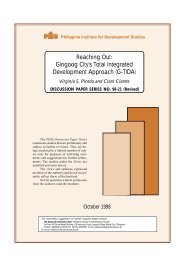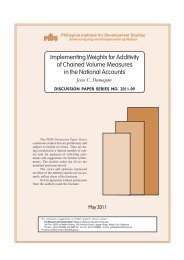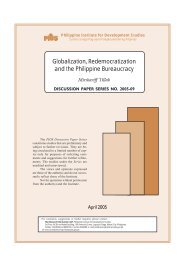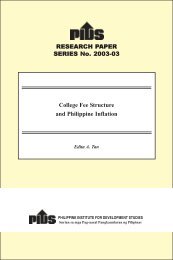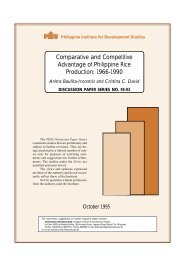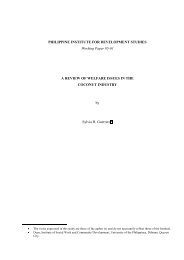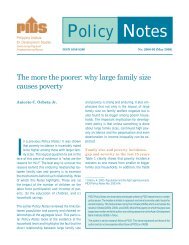Conditional Cash Transfer Program in the Philippines: Is It Reaching ...
Conditional Cash Transfer Program in the Philippines: Is It Reaching ...
Conditional Cash Transfer Program in the Philippines: Is It Reaching ...
You also want an ePaper? Increase the reach of your titles
YUMPU automatically turns print PDFs into web optimized ePapers that Google loves.
Philipp<strong>in</strong>e Institute for Development StudiesSurian sa mga Pag-aaral Pangkaunlaran ng Pilip<strong>in</strong>as<strong>Conditional</strong> <strong>Cash</strong> <strong>Transfer</strong> <strong>Program</strong><strong>in</strong> <strong>the</strong> Philipp<strong>in</strong>es: <strong>Is</strong> <strong>It</strong> Reach<strong>in</strong>g<strong>the</strong> Extremely Poor?Celia M. Reyes and Aubrey D. TabugaDISCUSSION PAPER SERIES NO. 2012-42The PIDS Discussion Paper Seriesconstitutes studies that are prelim<strong>in</strong>ary andsubject to fur<strong>the</strong>r revisions. They are be<strong>in</strong>gcirculated <strong>in</strong> a limited number of copiesonly for purposes of solicit<strong>in</strong>g commentsand suggestions for fur<strong>the</strong>r ref<strong>in</strong>ements.The studies under <strong>the</strong> Series areunedited and unreviewed.The views and op<strong>in</strong>ions expressedare those of <strong>the</strong> author(s) and do not necessarilyreflect those of <strong>the</strong> Institute.Not for quotation without permissionfrom <strong>the</strong> author(s) and <strong>the</strong> Institute.December 2012For comments, suggestions or fur<strong>the</strong>r <strong>in</strong>quiries please contact:The Research Information Staff, Philipp<strong>in</strong>e Institute for Development Studies5th Floor, NEDA sa Makati Build<strong>in</strong>g, 106 Amorsolo Street, Legaspi Village, Makati City, Philipp<strong>in</strong>esTel Nos: (63-2) 8942584 and 8935705; Fax No: (63-2) 8939589; E-mail: publications@pids.gov.phOr visit our website at http://www.pids.gov.ph
In <strong>the</strong> 2000 Millennium Declaration, <strong>the</strong> Philipp<strong>in</strong>es was among <strong>the</strong> many nations whichcommitted to reduce its poverty rate by 2015. There are only a few years left <strong>in</strong>to 2015 but <strong>the</strong>country’s poverty situation is still far from its target. Worse, <strong>the</strong> poverty trend is go<strong>in</strong>g upwards.In <strong>the</strong> newly improved poverty estimation, <strong>the</strong> poverty rate of <strong>the</strong> population climbed up from24.9 <strong>in</strong> 2003 to 26.4 <strong>in</strong> 2006 and <strong>in</strong>ched up fur<strong>the</strong>r to 26.5 percent <strong>in</strong> 2009 mark<strong>in</strong>g an <strong>in</strong>creaseof 3.3 million poor <strong>in</strong>dividuals from 2003 to 2009. 1Tackl<strong>in</strong>g <strong>the</strong> worsen<strong>in</strong>g poverty situation is one of <strong>the</strong> current government’s ma<strong>in</strong>anchors along with good governance. Good governance is <strong>the</strong> ma<strong>in</strong> <strong>in</strong>strument <strong>in</strong> fight<strong>in</strong>gpoverty (NAPC Part 1, 2011). The current adm<strong>in</strong>istration’s national anti-poverty program’scenterpiece is Pantawid Pamilyang Pilip<strong>in</strong>o <strong>Program</strong> (4Ps) or what is commonly-known as <strong>the</strong>conditional cash transfer (CCT) program. O<strong>the</strong>r current poverty reduction programs <strong>in</strong>clude <strong>the</strong>subsidized health <strong>in</strong>surance coverage, supplemental feed<strong>in</strong>g program, <strong>the</strong> food for work program,rice subsidy program, <strong>the</strong> SEA-K and <strong>the</strong> KALAHI-CIDSS among o<strong>the</strong>rs.To prove <strong>the</strong> serious <strong>in</strong>tent of <strong>the</strong> government to fight poverty, <strong>the</strong> social servicesallocation is already 34.1 percent of <strong>the</strong> total budget where<strong>in</strong> <strong>the</strong> first priority is to provide <strong>the</strong>basic <strong>in</strong>come, food and nutrition, health and education needs of <strong>the</strong> poor (NAPC Part 2, 2011).Among <strong>the</strong> various programs, <strong>the</strong> 4Ps by far is <strong>the</strong> most comprehensive and most controversialbecause of <strong>the</strong> huge amount <strong>the</strong> government is spend<strong>in</strong>g for this. This paper is devoted todiscuss<strong>in</strong>g briefly what <strong>the</strong> 4Ps is and how it has been implemented s<strong>in</strong>ce its <strong>in</strong>ception <strong>in</strong> 2007,identify<strong>in</strong>g some of <strong>the</strong> issues related to its design and implementation, and offer<strong>in</strong>g somerecommendations.What is <strong>the</strong> Pantawid Pamilya Pilip<strong>in</strong>o <strong>Program</strong>?The basic common structure of CCTs refers to transferr<strong>in</strong>g monetary and non-monetaryresources to <strong>the</strong> poor or poorest families who have school-aged children on <strong>the</strong> condition that<strong>the</strong>y meet certa<strong>in</strong> commitments aimed at improv<strong>in</strong>g <strong>the</strong>ir capacities (Cecch<strong>in</strong>i and Madariaga,2011). The first CCT programmes were launched <strong>in</strong> <strong>the</strong> 1990s <strong>in</strong> Brazil and Mexico. The ma<strong>in</strong>purpose was to provide cash transfers to families liv<strong>in</strong>g <strong>in</strong> extreme poverty <strong>in</strong> exchange forcommitments <strong>in</strong> education and healthcare. S<strong>in</strong>ce <strong>the</strong>n <strong>the</strong> CCT scheme has spread <strong>in</strong> many o<strong>the</strong>rcountries <strong>in</strong>clud<strong>in</strong>g <strong>the</strong> Philipp<strong>in</strong>es.The Philipp<strong>in</strong>es’ version of <strong>the</strong> CCT, <strong>the</strong> 4Ps, is patterned after <strong>the</strong> basic CCT structure.In <strong>the</strong> DSWD briefer of <strong>the</strong> 4Ps, it <strong>in</strong>dicated that “<strong>the</strong> Pantawid Pamilyang Pilip<strong>in</strong>o <strong>Program</strong>(4Ps) is a poverty reduction and social development strategy of <strong>the</strong> National Government thatprovides conditional cash grants to extremely poor households to improve <strong>the</strong>ir health, nutritionand education particularly of children aged 0-14.” <strong>It</strong> has dual objectives: (i) Social Assistance -1 This trend is consistent with <strong>the</strong> estimates <strong>in</strong> <strong>the</strong> old poverty estimation methodology2
to provide cash assistance to <strong>the</strong> poor to alleviate <strong>the</strong>ir immediate need (short term povertyalleviation); and (ii) Social Development - to break <strong>the</strong> <strong>in</strong>tergenerational poverty cycle through<strong>in</strong>vestments <strong>in</strong> human capital. <strong>It</strong> helps to fulfill <strong>the</strong> country’s commitment to meet <strong>the</strong>Millennium Development Goals, namely: (1) eradicate extreme poverty and hunger, (2) achieveuniversal primary education, (3) promote gender equality, (4) reduce child mortality, and (5)improve maternal health.The 4Ps offers 6,000 pesos annually (P500 per month) for each household selected by <strong>the</strong>programme for health and nutrition expenses. Also, it provides 3000 pesos per child for oneschool year (i.e. 10 months) or 300 pesos per month for educational expenses. Only up to amaximum of three children for each household can receive a subsidy. In return, <strong>the</strong> conditionsthat are to be met by beneficiaries are that - 1) pregnant women must avail of pre- and post-natalcare and be attended dur<strong>in</strong>g childbirth by a tra<strong>in</strong>ed health professional; 2) parents must attendfamily development sessions; 3) 0-5 year old children must receive regular preventive healthcheck-ups and vacc<strong>in</strong>es; 4) 3-5 year old children must attend day care or preschool classes atleast 85% of <strong>the</strong> time; 5) 6-14 year old children must enroll <strong>in</strong> elementary or high school andmust attend at least 85% of <strong>the</strong> time; and 6) 6-14 years old children must receive de-worm<strong>in</strong>gpills twice a year (DSWD website). The household beneficiaries will receive <strong>the</strong> subsidy, so longas <strong>the</strong>y comply with <strong>the</strong> conditionalities, for at most five years.The eligible beneficiaries are selected by DSWD from <strong>the</strong> poorest municipalities basedon <strong>the</strong> 2003 Small Area Estimates (SAE) of poverty <strong>in</strong>cidence generated by <strong>the</strong> NSCB.Municipalities with poverty <strong>in</strong>cidence higher than or equal to 50 percent are saturated – that is,all families are <strong>in</strong>terviewed and assessed for eligibility. In municipalities where <strong>the</strong> poverty<strong>in</strong>cidence is less than 50 percent, “pockets of poverty” are identified by <strong>the</strong> municipal socialwelfare and development officer and <strong>the</strong>n families <strong>in</strong> <strong>the</strong>se pockets are <strong>in</strong>terviewed and assessedfor eligibility. Families resid<strong>in</strong>g outside <strong>the</strong>se pockets of poverty are excluded <strong>in</strong> <strong>the</strong> assessmentanymore. This may lead to significant exclusion.Eligible households have <strong>in</strong>come that are equal to or below <strong>the</strong> prov<strong>in</strong>cial poverty l<strong>in</strong>e,have children 0 to 14 years old and/or a pregnant woman at <strong>the</strong> time of assessment; and thosewho agree to meet <strong>the</strong> conditions of <strong>the</strong> program.To obta<strong>in</strong> <strong>the</strong> poorest households <strong>in</strong> <strong>the</strong> municipalities, <strong>the</strong> DSWD uses <strong>the</strong> NationalHousehold Target<strong>in</strong>g System for Poverty Reduction (NHTS-PR). The system employs ProxyMeans Test Model to identify <strong>the</strong> poor families. The Proxy Means Test model was estimatedus<strong>in</strong>g data from <strong>the</strong> 2006 Family Income and Expenditure Survey and <strong>the</strong> 2006 Labor ForceSurvey. The assessmentt is conducted by us<strong>in</strong>g certa<strong>in</strong> proxy variables like ownership of assets,type of hous<strong>in</strong>g, education of household head, livelihood and access to water and sanitationfacilities to predict <strong>in</strong>come. To verify compliance, <strong>the</strong> DSWD coord<strong>in</strong>ates with <strong>the</strong> program’s3
multi-sectoral Advisory Committee to conduct monthly verification through <strong>the</strong> ComplianceVerification System (CVS) developed for <strong>the</strong> program.CoverageThe 4Ps was piloted <strong>in</strong> 2007 and was launched on a wider scale start<strong>in</strong>g 2008. To date,<strong>the</strong>re are already 2.3 million households <strong>in</strong> 80 prov<strong>in</strong>ces who are enrolled <strong>in</strong> <strong>the</strong> programme,cover<strong>in</strong>g 734 municipalities out of a total of 1, 495 municipalities, and 62 key cities out of 138cities. <strong>It</strong> targets 3 million household beneficiaries by end of 2012. 2 The expansion of <strong>the</strong> programs<strong>in</strong>ce 2008 necessitated <strong>the</strong> government to secure loans from <strong>the</strong> World Bank and <strong>the</strong> AsianDevelopment Bank amount<strong>in</strong>g to a total of $805 million or 34.6 billion pesos (De los Reyes,2011) to f<strong>in</strong>ance <strong>the</strong> program.Figure 1. Number of beneficiary households of 4Ps, Philipp<strong>in</strong>es<strong>Conditional</strong> cash transfers are popular <strong>in</strong> Lat<strong>in</strong> America and <strong>the</strong> Caribbean and are nowbe<strong>in</strong>g implemented <strong>in</strong> 18 countries <strong>in</strong> that region. The biggest programs are <strong>in</strong> Brazil andMexico. <strong>It</strong>s popularity is spread<strong>in</strong>g to Sou<strong>the</strong>ast Asia, with Indonesia implement<strong>in</strong>g it <strong>in</strong> 2007and <strong>the</strong>n followed by <strong>the</strong> Philipp<strong>in</strong>es. The idea of implement<strong>in</strong>g CCT <strong>in</strong> Indonesia first came up<strong>in</strong> 2005, as an alternative poverty reduction strategy for a major reduction <strong>in</strong> fuel subsidy.However, s<strong>in</strong>ce <strong>the</strong> <strong>in</strong>stitutional support did not yet exist and it would take a couple of years toset it up, <strong>the</strong> government decided to implement an unconditional cash transfer <strong>in</strong> 2005 3 . <strong>It</strong> onlyshifted to a conditional cash transfer <strong>in</strong> 2007.2 DSWD News Features: “Pantawid Pamilya Streng<strong>the</strong>ns Ties with CSOs,” dated December 5, 20113 Bloom, K. 2010 <strong>in</strong> Handayani and Burkley (eds). 20104
Accord<strong>in</strong>g to Cecch<strong>in</strong>i and Madariaga (2011), Ecuador has covered 100 percent of itspoor population; both Uruguay and Brazil, 84.6%; Mexico, 62.8%, and Colombia, 56.5%. Theseare <strong>the</strong> countries with <strong>the</strong> highest CCT coverage <strong>in</strong> terms of percent of poor population. With 2.3million beneficiaries represent<strong>in</strong>g, <strong>the</strong> Philipp<strong>in</strong>es’ CCT can be considered as one of <strong>the</strong> largerprograms <strong>in</strong> <strong>the</strong> world.Table 1. Coverage of <strong>Conditional</strong> <strong>Cash</strong> <strong>Transfer</strong> <strong>Program</strong> <strong>in</strong> Selected CountriesCountry <strong>Program</strong> Start Coverage (Number offamilies <strong>in</strong> millions)Mexico Progresa/Oportunidades 1997 5.6 (2010)Ecuador Solidarity Grant/Human 1998 1.2 (2010)Development GrantColombia Families <strong>in</strong> Action 2001 2.6 (2010)Brazil Bolsa Familia 2003 12.6 (2010)Indonesia <strong>Program</strong> Keluarga Harapan 2007 1.0 (2011)Philipp<strong>in</strong>es 4Ps 2007 2.3 (2011)Table is based from: Cecch<strong>in</strong>i and Madariaga, 2011.Source of Philipp<strong>in</strong>e data: DSWDSource of Indonesia data: http://pantawid.dswd.gov.ph/<strong>in</strong>dex.php/news/280-<strong>in</strong>donesian-delegationcommends-philipp<strong>in</strong>e-cct-dur<strong>in</strong>g-study-tour.Potential impacts and <strong>in</strong>itial reviewThe 4Ps is said to br<strong>in</strong>g about desired impacts on <strong>in</strong>come poverty and vulnerability <strong>in</strong> <strong>the</strong>short run. The ADB 4 cited an ex-ante analysis of 4Ps education grants and it noted that ifaccurately targeted to children <strong>in</strong> all poor households nationwide, <strong>the</strong> education component alonecould lift 31.1% of poor households out of poverty and decrease <strong>the</strong> national poverty gapmeasure by 52.5% (ADB, n.d.). The document fur<strong>the</strong>r claims that s<strong>in</strong>ce <strong>the</strong> 4Ps has targeted <strong>the</strong>poor areas, <strong>the</strong> impact would be much larger. The estimated <strong>in</strong>crease <strong>in</strong> <strong>the</strong> total <strong>in</strong>comes of <strong>the</strong>poor and eligible households <strong>in</strong> <strong>the</strong> targeted areas per World Bank is 23 percent, where <strong>the</strong>poverty rate is expected to fall by 6.1 percentage po<strong>in</strong>ts.In <strong>the</strong> long-run, <strong>the</strong> 4Ps’ goal is to achieve improvements <strong>in</strong> human capital. The 4Ps isseen to have great potential <strong>in</strong> <strong>in</strong>creas<strong>in</strong>g educational atta<strong>in</strong>ment and improv<strong>in</strong>g nutrition andhealth outcomes based on <strong>the</strong> experience of o<strong>the</strong>r countries who have implemented <strong>the</strong> CCT.One of <strong>the</strong> problems <strong>in</strong> <strong>the</strong> educational system that <strong>the</strong> 4Ps is expected to impact is <strong>in</strong>creas<strong>in</strong>gdropout rates. The CCT programs <strong>in</strong> o<strong>the</strong>r countries have been successful <strong>in</strong> achiev<strong>in</strong>g higherenrolment rates.4 An ADB project document obta<strong>in</strong>ed onl<strong>in</strong>e from http://www.adb.org/Documents/RRPs/PHI/43407/43407-01-phiea.pdf5
Meanwhile, <strong>the</strong> 4Ps is expected to <strong>in</strong>crease utilization of health services among <strong>the</strong> pooras <strong>the</strong> additional cash <strong>the</strong>y receive will help cover costs; and improve nutritional status ofchildren through <strong>in</strong>creased household <strong>in</strong>come and various counsell<strong>in</strong>g and monitor<strong>in</strong>gcomponents of <strong>the</strong> 4Ps.Among o<strong>the</strong>r broader potential benefits of <strong>the</strong> 4Ps <strong>in</strong>clude magnified multiplier effect of<strong>the</strong> cash flow on <strong>the</strong> local economy know<strong>in</strong>g that <strong>the</strong>se were paid to women who are believed totypically <strong>in</strong>vest more on education and health care; <strong>in</strong>creased f<strong>in</strong>ancial literary of <strong>the</strong> poor which<strong>in</strong> turn can enhance <strong>the</strong>ir sav<strong>in</strong>gs behaviour; and <strong>in</strong>creased barga<strong>in</strong><strong>in</strong>g power with<strong>in</strong> <strong>the</strong>household (ADB, n.d.).To date, <strong>the</strong>re has been no rigorous evaluation of <strong>the</strong> 4Ps.A simple before-and-after comparison of <strong>the</strong> growth rate <strong>in</strong> school enrolment was doneby Manasan (2011) for Set 1 areas of <strong>the</strong> 4Ps. The result provides some <strong>in</strong>dication of <strong>the</strong> 4Ps’success <strong>in</strong> improv<strong>in</strong>g school attendance though this is yet to be confirmed us<strong>in</strong>g more rigorousanalyses. The paper shows that <strong>the</strong> growth rate of enrolment <strong>in</strong> 2008-2010 is significantly higherfor both public elementary and secondary levels than that dur<strong>in</strong>g <strong>the</strong> pre-4Ps period. This wasobserved from Set 1 areas of <strong>the</strong> 4Ps outside of National Capital Region (NCR) and ARMM. Set1 refers to <strong>the</strong> first phase of 4Ps expansion completed <strong>in</strong> end of 2008 cover<strong>in</strong>g 160municipalities. The rise <strong>in</strong> <strong>the</strong> enrolment growth rate is higher for elementary than for <strong>the</strong>secondary level. Gross enrolment rate also improved <strong>in</strong> <strong>the</strong> said areas. <strong>It</strong> is noteworthy that saideducation <strong>in</strong>dicators improved for Set 1 areas <strong>in</strong> <strong>the</strong> ARMM both <strong>in</strong> elementary and secondarylevels albeit, delayed for <strong>the</strong> elementary level. Meanwhile, improvements were not seen for Set 1areas <strong>in</strong> NCR and this as Manasan (2011) mentioned needs fur<strong>the</strong>r <strong>in</strong>vestigation.In an overview of <strong>the</strong> 4Ps by Fernandez and Olf<strong>in</strong>do (2011), it was noted that thisprogram was successfully rolled out to <strong>the</strong> poorest households. In particular, <strong>the</strong> DSWD andpartner agencies had successfully implemented <strong>the</strong> pilot program and established <strong>the</strong> target<strong>in</strong>gsystem necessary for expansion. The authors also marked that <strong>the</strong> target<strong>in</strong>g system based on <strong>the</strong>PMT has produced good results as about 90 percent of <strong>the</strong> beneficiaries belong to <strong>the</strong> bottom 40percent of <strong>the</strong> population and 72 percent belong to <strong>the</strong> poorest 20 percent. They also presented ananecdotal evidence that <strong>the</strong> net education enrolment rates of children <strong>in</strong> <strong>the</strong> targeted householdshave risen while <strong>the</strong> number of children who have availed of <strong>the</strong> health services has also<strong>in</strong>creased. Accord<strong>in</strong>g to Fernandez and Olf<strong>in</strong>do (2011), an impact evaluation of <strong>the</strong> 4Ps wasscheduled <strong>in</strong> 2011, <strong>the</strong> results of which are not yet released to <strong>the</strong> public as of publication time ofthis paper.Fernandez and Olf<strong>in</strong>do (2011) noted key challenges <strong>in</strong> <strong>the</strong> implementation of <strong>the</strong> 4Ps.Due to <strong>the</strong> complexity of <strong>the</strong> adm<strong>in</strong>istrative processes <strong>in</strong>volved <strong>in</strong> implement<strong>in</strong>g a CCT program,<strong>the</strong> DSWD faced challenges <strong>in</strong> terms of available resources for <strong>the</strong> program such as personnel,equipment, and f<strong>in</strong>ancial resources. These challenges were exacerbated by <strong>the</strong> rapid scal<strong>in</strong>g up of6
<strong>the</strong> program which happened when <strong>the</strong> systems were still be<strong>in</strong>g developed. The study likewisenoted that <strong>the</strong> "rigid <strong>in</strong>stitutional structure and weak procurement system" were constra<strong>in</strong>ts <strong>in</strong> <strong>the</strong>expansion of <strong>the</strong> program's human and capital resources. For <strong>in</strong>stance, <strong>the</strong> staff<strong>in</strong>g for <strong>the</strong>national PMO was only 69 percent of <strong>the</strong> positions needed by end of 2010 and that for <strong>the</strong>regional PMO, only 74 percent of <strong>the</strong> approved positions. Delays <strong>in</strong> implementation was alsocaused by weak procurement system of <strong>the</strong> DSWD which hampered <strong>the</strong> necessary IT systems <strong>in</strong><strong>the</strong> regions. Moreover, key challenges <strong>in</strong>volved <strong>the</strong> supply-side preparedness of <strong>the</strong> target areas.Because <strong>the</strong> program has been scaled-up <strong>in</strong> a rapid pace, some municipalities with a highconcentration of <strong>the</strong> poor with <strong>in</strong>adequate education and health facilities have been <strong>in</strong>cluded <strong>in</strong><strong>the</strong> program. Spot check surveys conducted by <strong>the</strong> AusAID and World Bank found poor state ofday care centers and school <strong>in</strong>frastructure; and lack of teachers <strong>in</strong> <strong>the</strong> schools of children ofbeneficiaries. This lack of facilities has a major implication for beneficiary compliance withconditionalities.Design and Implementation <strong>Is</strong>suesS<strong>in</strong>ce its <strong>in</strong>ception, <strong>the</strong> 4Ps has been <strong>the</strong> subject of many praises and criticisms. <strong>It</strong> hasbeen hailed as a program to help fulfill <strong>the</strong> country’s commitment to meet five of <strong>the</strong> eightMillennium Development Goals, namely: (1) eradicate extreme poverty and hunger, (2) achieveuniversal primary education, (3) promote gender equality, (4) reduce child mortality, and (5)improve maternal health. On <strong>the</strong> o<strong>the</strong>r hand, some have questioned whe<strong>the</strong>r this is <strong>the</strong> mosteffective and susta<strong>in</strong>able way of reduc<strong>in</strong>g poverty.Target<strong>in</strong>gOne of <strong>the</strong> ma<strong>in</strong> issues be<strong>in</strong>g raised concerns target<strong>in</strong>g, or selection of beneficiaries.Various reports on <strong>the</strong> status of <strong>the</strong> 4Ps focus on its poor target<strong>in</strong>g as <strong>the</strong> DSWD delists many ofits target beneficiaries. In fact, as of November 2011, <strong>the</strong>re were already 171,947 households 5 (or7.5% of total 2.3 million household beneficiaries <strong>the</strong> program has served so far) who weredelisted from <strong>the</strong> program. The delisted households <strong>in</strong>cluded those who were found to be nonpooror those with stable <strong>in</strong>come sources and those who did not comply with <strong>the</strong> program’sconditions.In addition, <strong>the</strong> National Household Target<strong>in</strong>g System for Poverty Reduction (NHTS-PR), from which <strong>the</strong> 4Ps draws its list of poor households, shows that <strong>the</strong>re were 5.2 million poorfamilies <strong>in</strong> 2009. However, this has not successfully predicted <strong>the</strong> official poverty estimate <strong>in</strong>2009 of 4.9 million poor families, based on <strong>the</strong> old methodology of poverty estimation, nor <strong>the</strong>3.9 million poor families based on <strong>the</strong> ref<strong>in</strong>ed methodology. The proxy means test model ofNHTS-PR) is overestimat<strong>in</strong>g <strong>the</strong> number of poor families. Already we can see <strong>the</strong> leakages as5 http://pantawid.dswd.gov.ph/<strong>in</strong>dex.php/news/279-dswd-clarifies-coa-report7
shown by <strong>the</strong> number of families delisted. A study done by Fernandez and Olf<strong>in</strong>do (2011) us<strong>in</strong>g<strong>the</strong> 2009 FIES reveals that 72 percent of <strong>the</strong> beneficiaries <strong>in</strong> 2009 below to <strong>the</strong> bottom 20 percentof <strong>the</strong> families. Official estimate of poverty <strong>in</strong>cidence for <strong>the</strong> same year is 20.9 percent. Thus,about 73 percent of <strong>the</strong> beneficiaries can be classified as poor. For every 100 beneficiaries, 73are poor and 27 are non-poor. This suggests <strong>the</strong> need to f<strong>in</strong>e-tune <strong>the</strong> program’s target<strong>in</strong>g schemeprior to fur<strong>the</strong>r expansion.To create a benchmark for assess<strong>in</strong>g <strong>the</strong> target<strong>in</strong>g outcome of <strong>the</strong> 4Ps, <strong>the</strong> Bolsa Familiawas a good example of a well-targeted program where <strong>the</strong> poorest quartile (25%) of <strong>the</strong>population received 80% of all benefits. The leakage rate <strong>the</strong>refore was only about one-fifth(L<strong>in</strong>dert, L<strong>in</strong>der, Hobbs, and de la Briere, 2007). Meanwhile, <strong>the</strong>n Progresa, was more successful<strong>in</strong> identify<strong>in</strong>g <strong>the</strong> extremely poor households with<strong>in</strong> localities than <strong>in</strong> select<strong>in</strong>g households thatare moderately poor (Skoufias, Davis, and Behrman 1999). Coady and Parker (2004) <strong>in</strong> Azevedoand Robles (n.d., p.7), <strong>in</strong> a quantitative analysis, obta<strong>in</strong>ed a leakage rate of 22 percent for <strong>the</strong>Oportunidades. Because of effective target<strong>in</strong>g, <strong>the</strong> Bolsa Familia and Oportunidades was able tosuccessfully reduce <strong>in</strong>equality (Soares, Osorio, Soares, Medeiros, and Zepeda (2007), p.11).Figure 2. Number of beneficiary households of selected CCT progrmasMore importantly, <strong>the</strong> 4Ps failed to account as well that <strong>the</strong> poor is not a homogeneousgroup nor has targeted <strong>the</strong> extremely poor which is by official def<strong>in</strong>ition may refer to <strong>the</strong> food8
poor (those liv<strong>in</strong>g below subsistence level). In 2009, <strong>the</strong>re are about 2 million familiesconsidered to be subsistence poor or those who are extremely poor <strong>the</strong>y could not even afford tomeet <strong>the</strong>ir basic food needs. This amounts to roughly only more than a third of <strong>the</strong> current totalnumber of poor households, at 5.2 million, be<strong>in</strong>g used by <strong>the</strong> 4Ps as its universe of poorhouseholds. In <strong>the</strong> Bolsa Familia of Brazil, <strong>the</strong> difference <strong>in</strong> <strong>the</strong> conditions of <strong>the</strong> poor has beentaken <strong>in</strong>to account when <strong>the</strong>y differentiated <strong>the</strong> amount of transfer given to <strong>the</strong> extremely poorand <strong>the</strong> moderately poor. In Soares, Osorio, Soares, Medeiros, and Zepeda (2007), <strong>the</strong> maximumamount of transfer <strong>in</strong> <strong>the</strong> Bolsa Familia to a family of extreme poverty is roughly $91 PPP permonth for each family while <strong>the</strong> moderately poor receives up to only $42 PPP.Moreover, <strong>the</strong> poor consists of <strong>the</strong> chronically or persistently poor and <strong>the</strong> transient pooror those who become poor because of certa<strong>in</strong> shocks. In fact, more than half (52.6%) of Filip<strong>in</strong>ofamilies who are classified as poor <strong>in</strong> 2009 were transient poor. These are households who aremov<strong>in</strong>g <strong>in</strong> and out of poverty. Only 47.4 percent of poor households <strong>in</strong> 2009 were consistentlypoor s<strong>in</strong>ce 2003 (Reyes, et al., 2011). These two groups have vary<strong>in</strong>g characteristics. Thechronic poor face constra<strong>in</strong>ts that are caused by <strong>the</strong>ir lack of capacity; <strong>the</strong>y are mostlyuneducated and are more likely to perpetuate poverty (i.e. <strong>in</strong>tergenerational poverty) because<strong>the</strong>y could not send <strong>the</strong>ir children to school. Poverty reduction <strong>in</strong>tervention for this group takessusta<strong>in</strong>ed efforts. The transient poor meanwhile are those who become poor dur<strong>in</strong>g certa<strong>in</strong>periods due to economic shocks or natural calamities but may be able to recover when given crop<strong>in</strong>surance, access to credit or emergency employment programs. They have better capacity than<strong>the</strong> chronic poor and <strong>the</strong>ir needs may be <strong>in</strong>termittent. The CCT program, as we know it, normallycaters to <strong>the</strong> chronic poor or <strong>the</strong> extremely poor, as. In <strong>the</strong> target<strong>in</strong>g scheme of <strong>the</strong> 4Ps however,such heterogeneity of <strong>the</strong> poor was not taken <strong>in</strong>to consideration.Size of <strong>the</strong> cash transferIn provid<strong>in</strong>g cash grants, programs also need to account for <strong>the</strong> distance of <strong>the</strong> poor from<strong>the</strong> poverty l<strong>in</strong>e to ensure that <strong>the</strong> amount is of value that would yield an impact. On <strong>the</strong> average,<strong>the</strong> chronic poor’s <strong>in</strong>come has to be augmented by around 5000 pesos per person annually (orabout 32% of <strong>the</strong> poverty threshold) to meet <strong>the</strong> poverty l<strong>in</strong>e based on 2009 <strong>in</strong>come data of <strong>the</strong>chronic poor and 2009 poverty l<strong>in</strong>e. This amount represents <strong>the</strong> <strong>in</strong>come gap of <strong>the</strong> chronic poorfrom <strong>the</strong> poverty l<strong>in</strong>e. The 4Ps provide poor families of five members a maximum amount of15,000 pesos annually (assum<strong>in</strong>g that <strong>the</strong>y have 3 eligible children) or 3,000 per person. Withthis amount, only around a quarter of <strong>the</strong> chronic poor (26%) are able to get out of povertyassum<strong>in</strong>g <strong>the</strong>y do not get exposed to significant economic shocks. Meanwhile, <strong>the</strong> <strong>in</strong>come of <strong>the</strong>transient poor has to be augmented by around 3,400 pesos per person annually. Given <strong>the</strong> actualper capita <strong>in</strong>come of <strong>the</strong> transient poor <strong>in</strong> 2009, <strong>the</strong> 4Ps cash grant can lift only about half of <strong>the</strong>transient poor out of <strong>in</strong>come poverty.9
Based on <strong>the</strong> full survey data of <strong>the</strong> 2009 FIES, <strong>the</strong> <strong>in</strong>come of <strong>the</strong> poor, be it chronic ortransient, have to be augmented an average amount of 4,300 pesos for <strong>the</strong>m to get out of poverty.If we employ <strong>the</strong> cash grant to <strong>the</strong> poor, assum<strong>in</strong>g that <strong>the</strong>y were targeted successfully, <strong>the</strong>program is able to lift only 39 percent of those poor <strong>in</strong> 2009.Experiences of o<strong>the</strong>r countriesThe experiences of o<strong>the</strong>r countries show that <strong>the</strong> CCT can <strong>in</strong>deed br<strong>in</strong>g about goodresults. Various studies on <strong>the</strong> impact of CCT programs <strong>in</strong> many countries show that <strong>the</strong>re havebeen improvements <strong>in</strong> terms of <strong>the</strong> immediate goals like better access to schools and healthservices. However, <strong>the</strong>re were no conclusive reports on learn<strong>in</strong>g or health and nutritional statusof children. Increases <strong>in</strong> enrolment due to CCT were noted <strong>in</strong> Mexico’s Progresa, PATH <strong>in</strong>Jamaica, Solidarity program <strong>in</strong> Dom<strong>in</strong>ican Republic, Tekopora programme <strong>in</strong> Paraguay(Cecch<strong>in</strong>i and Madariaga, 2011 cit<strong>in</strong>g various studies). O<strong>the</strong>r effects <strong>in</strong>clude eradication of <strong>the</strong>gender gaps <strong>in</strong> enrolment and reduction of dropout rates but <strong>the</strong>se were specific on areas, ages,and school levels.In terms of <strong>the</strong> health and nutrition aspects, <strong>the</strong> CCTs resulted to <strong>in</strong>creased coverage forchildren growth checks and preventive medical tests. However, <strong>the</strong> impact on children’s healthand nutritional status is uneven. The Progresa <strong>in</strong> Mexico and RPS <strong>in</strong> Nicaragua yieldedimprovements <strong>in</strong> child height while PRAF <strong>in</strong> Honduras and BA <strong>in</strong> Brazil had no mean<strong>in</strong>gfulimpact on preschool nutritional status (Hodd<strong>in</strong>ott and Bassett, 2008) In many cases, <strong>the</strong>sepositive impacts both on education and health were specific on areas, ages, and school levels (foreducation impacts). 6Because <strong>the</strong> cash transfers tend to focus on <strong>the</strong> poorest groups and are not large <strong>in</strong> termsof amount, <strong>the</strong> impact on poverty at <strong>the</strong> aggregate level is visible mostly on poverty gap andseverity <strong>in</strong>dicators. The transfers <strong>the</strong>refore can only raise <strong>the</strong> poor’s status closer to <strong>the</strong> threshold.Countries like Argent<strong>in</strong>a, Brazil, Ecuador, Jamaica, and Mexico where <strong>the</strong>re is considerablescope of <strong>the</strong> CCT and <strong>the</strong> amount of <strong>the</strong> cash grants are significant experienced positive effectson poverty at <strong>the</strong> national level. For those where <strong>the</strong>re is low coverage and lower transferamounts (like Honduras), <strong>the</strong>re is no substantial impact on poverty. This is also <strong>the</strong> case forimpacts of <strong>the</strong> CCT on <strong>in</strong>come distribution. Countries which have substantial transfer amountslike those of Mexico and Brazil were able to reduce <strong>in</strong>equality more significantly while that forChile where <strong>the</strong> amount of transfer was low, <strong>the</strong> effect on <strong>in</strong>equality has been very modest(Soares, Osorio, Soares, Medeiros, and Zepeda, 2007).6 There were methodological issues thrown at <strong>the</strong> manners by which <strong>the</strong> studies have been undertaken. A study byYounger, Ponce, and Hidalgo (2009) on assessments on <strong>the</strong> Progresa and Oportunidades noted by Cecch<strong>in</strong>i andMadariaga showed that chang<strong>in</strong>g <strong>the</strong> source of <strong>in</strong>formation, measurement period or methods used <strong>in</strong> <strong>the</strong>seassessments radically altered <strong>the</strong> results.10
The CCT programmes have been fairly successful <strong>in</strong> upper middle-<strong>in</strong>come countries likeBrazil and Mexico, but this does not mean that it can work <strong>in</strong> all countries. Several low-<strong>in</strong>comecountries which have adopted <strong>the</strong> model like Guatemala, Honduras and Nicaragua have facedimmense challenges <strong>in</strong> implement<strong>in</strong>g CCT programmes because <strong>the</strong>y did not meet <strong>the</strong> necessaryprerequisites (Cecch<strong>in</strong>i, 2009). The first requirement is that <strong>the</strong>re has to be a multidimensionalapproach to poverty reduction, hence demand<strong>in</strong>g coord<strong>in</strong>ation among all agencies implement<strong>in</strong>gpoverty reduction efforts. Therefore, strong and coord<strong>in</strong>ated <strong>in</strong>stitutions are critical. Second, ithas to be a state policy where<strong>in</strong> <strong>the</strong> programme can withstand changes <strong>in</strong> adm<strong>in</strong>istrations andfund<strong>in</strong>g must not rely from external sources for <strong>the</strong> programme needs to be susta<strong>in</strong>ed for a longperiod of time. Third, <strong>the</strong>re has to be strong statistical capacity and bank<strong>in</strong>g systems. Suchimportant prerequisites are often lack<strong>in</strong>g <strong>in</strong> low-<strong>in</strong>come countries (Cecch<strong>in</strong>i, 2009).Ano<strong>the</strong>r important requirement to achieve successful results from <strong>the</strong> CCT is thatimpos<strong>in</strong>g conditions should mean that <strong>the</strong> necessary services are <strong>in</strong> fact <strong>in</strong> place and that <strong>the</strong>y areof good quality. For <strong>in</strong>stance, provid<strong>in</strong>g some cash to families on <strong>the</strong> condition that <strong>the</strong>ir childrenattend school or do health check-ups is <strong>in</strong>appropriate <strong>in</strong> areas where <strong>the</strong>re are no school oraccessible health centers nearby to go to. Thus, CCT funds should not only be devoted tostimulat<strong>in</strong>g demand for social services but also by <strong>in</strong>creas<strong>in</strong>g <strong>the</strong> supply of social services likeeducation and health services to meet <strong>the</strong> <strong>in</strong>creas<strong>in</strong>g demands.In 2008, when <strong>the</strong> Philipp<strong>in</strong>es launched nationwide <strong>the</strong> CCT, <strong>the</strong>re were still greatshortages <strong>in</strong> classrooms and school teachers and various issues still plague <strong>the</strong> health sector. In2011, <strong>the</strong> supply side allocations for <strong>the</strong> 4Ps <strong>in</strong>clude 12.4 billion pesos for build<strong>in</strong>g classroomsand 1.6 billion pesos for <strong>the</strong> creation of 10,000 teach<strong>in</strong>g positions. The government alsoallocated 7.1 billion pesos for upgrad<strong>in</strong>g of health facilities (NAPC Part 1, 2011). Hence, <strong>the</strong>government realizes <strong>the</strong> importance of supply-side factors to achieve <strong>the</strong> goals of <strong>the</strong> 4Ps. Thus,it would have been better to put <strong>in</strong> place <strong>the</strong>se facilities prior to ra<strong>the</strong>r than concurrently with <strong>the</strong>expansion of <strong>the</strong> program. Hence, <strong>the</strong> lack of preparedness towards full implementation of <strong>the</strong>CCT was truly one of <strong>the</strong> critical issues. Moreover, <strong>in</strong> 2011, <strong>the</strong> NAPC writes that <strong>the</strong>re were somany uncoord<strong>in</strong>ated and overlapp<strong>in</strong>g poverty-reduction-related programs reflect<strong>in</strong>g <strong>the</strong> lack ofcoord<strong>in</strong>ative mechanisms among various agencies.Apparently, <strong>the</strong> Philipp<strong>in</strong>es lack preparedness based on <strong>the</strong> requirements described <strong>in</strong>Cecch<strong>in</strong>i (2009). Fernandez and Olf<strong>in</strong>do (2011) noted that <strong>the</strong> program was scaled up when <strong>the</strong>systems were still under development and this posed considerable challenges <strong>in</strong> <strong>the</strong>implementation. In particular, <strong>the</strong> study noted that <strong>the</strong> rigid <strong>in</strong>stitutional structure and weakprocurement system have constra<strong>in</strong>ed <strong>the</strong> expansion of human and capital support for <strong>the</strong>Pantawid Pamilya. Fur<strong>the</strong>rmore, <strong>the</strong> study highlighted that <strong>the</strong> rapid expansion has also posedchallenges to supply-side read<strong>in</strong>ess <strong>in</strong> areas where Pantawid Pamilya were implemented. Thereare several questions that need answers. Why <strong>the</strong> rush <strong>in</strong> implement<strong>in</strong>g <strong>the</strong> program at such an11
unprecedented pace? How long can we susta<strong>in</strong> such a huge amount of spend<strong>in</strong>g <strong>in</strong> order for <strong>the</strong>program to have an impact of <strong>the</strong> poor’s lives? Based on o<strong>the</strong>r countries’ experiences, <strong>the</strong> CCTshould be backed by a state policy so that fund<strong>in</strong>g need not rely on external sources as it needs tobe susta<strong>in</strong>ed for a long time. How much more should we borrow to f<strong>in</strong>ance a program this big ascale? <strong>Is</strong> <strong>the</strong>re any more fiscal space <strong>in</strong> which we can accommodate this given <strong>the</strong> already tightbudget that we have?RecommendationsThe conditional cash transfer program, <strong>the</strong> 4Ps, is <strong>in</strong> its fifth year. The current size of <strong>the</strong>4Ps is already significant with 2.3 million family beneficiaries, given that <strong>the</strong> number of poorfamilies is 3.9 million. Before fur<strong>the</strong>r scal<strong>in</strong>g up, it is essential to assess <strong>the</strong> implementation of<strong>the</strong> Pantawid Pamilya Pilip<strong>in</strong>o <strong>Program</strong> (4Ps) and address <strong>the</strong> concerns about <strong>the</strong> program toensure that <strong>the</strong> extremely poor experience <strong>the</strong> maximum benefits from <strong>the</strong> program. The samewas suggested by Llanto (2008). He noted that it is important to establish empirical evidence that<strong>the</strong> 4Ps program impacts human capital outcomes before contemplat<strong>in</strong>g any rapid expansion.The 4Ps be<strong>in</strong>g implemented on a phased model allows for this generation of empirical evidenceto test crucial program components such as target<strong>in</strong>g and monitor<strong>in</strong>g system.More importantly, it should reconsider how it identifies <strong>the</strong> extremely poor. Target<strong>in</strong>g <strong>the</strong>chronic poor would provide better focus to <strong>the</strong> program. Moreover, to properly identify <strong>the</strong>extremely poor, one needs to utilize more than one reference period to account for <strong>the</strong>movements <strong>in</strong> and out of poverty. Data show that majority of <strong>the</strong> poor <strong>in</strong> 2009 are transient poor,only 47 percent are considered chronic poor (Reyes, et.al. 2011). This important <strong>in</strong>formation wasextracted us<strong>in</strong>g longitud<strong>in</strong>al data obta<strong>in</strong>ed from track<strong>in</strong>g <strong>the</strong> same households for several years.The f<strong>in</strong>d<strong>in</strong>g evidently shows that target<strong>in</strong>g <strong>the</strong> poor based on a s<strong>in</strong>gle reference period andtreat<strong>in</strong>g <strong>the</strong>m as if <strong>the</strong>y are all <strong>the</strong> same would be too narrow a strategy that will not tacklepoverty successfully. <strong>Program</strong>s have to be designed to comprehensively take <strong>in</strong>to account <strong>the</strong>differences among <strong>the</strong> needs of different segments of <strong>the</strong> poor.Moreover, it might be good to review <strong>the</strong> strategy of cover<strong>in</strong>g selected barangays <strong>in</strong> someof <strong>the</strong> municipalities. Limit<strong>in</strong>g coverage to “pockets of poverty” <strong>in</strong> areas where poverty<strong>in</strong>cidence is high based on 2003 small area estimates may lead to significant exclusion. Only 25percent, or 404 municipalities and cities, have poverty <strong>in</strong>cidence greater than or equal to 50percent. The rest, represent<strong>in</strong>g 3 out of every 4 municipality and city, have poverty <strong>in</strong>cidenceless than 50 percent. Limit<strong>in</strong>g survey area to “poorest municipalities” to reduce data collectioncosts may not be <strong>the</strong> most appropriate way s<strong>in</strong>ce this will lead to exclusion of some of <strong>the</strong>extremely poor. O<strong>the</strong>r options such as us<strong>in</strong>g CBMS data already collected by <strong>the</strong> localgovernment units or partner<strong>in</strong>g with local government units <strong>in</strong> implement<strong>in</strong>g CBMS may be a12
more practical solution. This would not only avoid duplication of efforts and wastage ofresources, but it would also encourage greater buy-<strong>in</strong> by <strong>the</strong> local governments <strong>in</strong> nationalprograms.The first batch of beneficiaries will be reach<strong>in</strong>g its fifth year <strong>in</strong> 2012. <strong>It</strong> would be timelyto assess <strong>the</strong> impacts of <strong>the</strong> program by exam<strong>in</strong><strong>in</strong>g <strong>the</strong> situation of this group of families andwhe<strong>the</strong>r 4Ps has <strong>in</strong>deed improved <strong>the</strong> health, education, nutrition and poverty outcomes of <strong>the</strong>sefamilies. Moreover, it would be good to see whe<strong>the</strong>r <strong>the</strong> exit policy of <strong>the</strong> program (<strong>the</strong>beneficiary can only participate <strong>in</strong> <strong>the</strong> program by at most 5 years) is feasible,<strong>It</strong> would also be helpful if <strong>the</strong> NHTS updates its proxy means test model for its target<strong>in</strong>gsystem by us<strong>in</strong>g <strong>the</strong> most recent Family Income and Expenditure Survey data and adopt<strong>in</strong>g <strong>the</strong>revised estimates of poverty thresholds. This would likely address <strong>the</strong> seem<strong>in</strong>gly too largenumber of eligible beneficiaries be<strong>in</strong>g identified by <strong>the</strong> current system.<strong>It</strong> is also important to evaluate how effective <strong>the</strong> program is <strong>in</strong> terms of <strong>the</strong> amount of <strong>the</strong>grant. <strong>Is</strong> <strong>the</strong> size enough to encourage <strong>the</strong> children to rema<strong>in</strong> <strong>in</strong> school? Do we see evidence ofreduced participation <strong>in</strong> <strong>the</strong> labor force because of <strong>the</strong> transfer?To conclude, it is critical that an impact monitor<strong>in</strong>g and evaluation be done at this stageto improve <strong>the</strong> mechanisms of identify<strong>in</strong>g <strong>the</strong> beneficiaries to m<strong>in</strong>imize leakages and exclusion,address loopholes <strong>in</strong> <strong>the</strong> system to avoid wastage of scarce resources, and address <strong>the</strong> supplysidedeficiencies. The 4Ps is such an important and expensive program and go<strong>in</strong>g on hastily withfur<strong>the</strong>r expansion with all <strong>the</strong>se concerns is <strong>the</strong> last th<strong>in</strong>g a poverty-stricken, budget-constra<strong>in</strong>ed,and highly <strong>in</strong>debted country like <strong>the</strong> Philipp<strong>in</strong>es should be do<strong>in</strong>g.ReferencesAzevedo, V. and M. Robles. n.d. Multidimensional Target<strong>in</strong>g: Identify<strong>in</strong>g Beneficiaries of<strong>Conditional</strong> <strong>Cash</strong> <strong>Transfer</strong> <strong>Program</strong>s. Available onl<strong>in</strong>e athttp://www.chronicpoverty.org/uploads/publication_files/azevedo_robles_multidimensional.pdf. Retrieved February 22,2012.Barrientos, A., D. Hulme, and K. Moore. 2006. Social Protection for <strong>the</strong> Poorest: Tak<strong>in</strong>g aBroader View In Poverty <strong>in</strong> Focus: Social Protection: <strong>the</strong> role of cash transfers. InternationalPoverty Centre. United Nations Development <strong>Program</strong>me. June 2006.pp. 6-8 Availableonl<strong>in</strong>e at http://www.ipc-undp.org/pub/IPCPovertyInFocus8.pdf Retrieved January 3, 2011.Bloom, K.S. 2010. <strong>Transfer</strong>s: Lessons from Indonesia’s <strong>Program</strong> Keluarga Harapan <strong>in</strong> S.W.Handayani and C. Burkley. Social Assistance and <strong>Conditional</strong> <strong>Cash</strong> <strong>Transfer</strong>s: Proceed<strong>in</strong>gsof <strong>the</strong> Regional Workshop. Asian Development Bank.13
Cecch<strong>in</strong>i, S. and A. Madariaga. 2011. <strong>Conditional</strong> <strong>Cash</strong> <strong>Transfer</strong> <strong>Program</strong>mes: The RecentExperience <strong>in</strong> Lat<strong>in</strong> America and <strong>the</strong> Caribbean. United Nations Economic Commission forLat<strong>in</strong> America and <strong>the</strong> Caribbean (ECLAC). Chile. United Nations.Cecch<strong>in</strong>i, S. 2009. Do CCT <strong>Program</strong>mes Work <strong>in</strong> Low-Income Countries? International PolicyCentre for Inclusive Growth One Pager No. 90. July 2009. Available onl<strong>in</strong>e athttp://www.ipc-undp.org/pub/IPCOnePager90.pdf. Retrieved December 18, 2011De los Reyes, C. May 2011. CCT debt trap? Future of pro-poor deal a poser. May 31, 2011.Philipp<strong>in</strong>e Center for Investigative Journalism (PCIJ). Available onl<strong>in</strong>e athttp://pcij.org/stories/cct-debt-trap-future-of-pro-poor-deal-a-poser/ Retrieved December 18,2011.Department of Social Welfare and Development. Pantawid Pamilyang Pilip<strong>in</strong>o <strong>Program</strong> Briefer.Available onl<strong>in</strong>e at http://pantawid.dswd.gov.ph/images/stories/briefernew.pdf RetrievedDecember 18, 2011.Department of Social Welfare and Development. December 2011. Pantawid Pamilya Registers2.3 Millionth Household Beneficiary. DSWD Social Market<strong>in</strong>g Service. Available onl<strong>in</strong>e athttp://www.dswd.gov.ph/<strong>in</strong>dex.php/component/content/article/1-latest-news/2461--pantawid-pamilya-registers-23-millionth-household-beneficiary Retrieved December19,2011Fernandez, Luisa and Rosech<strong>in</strong> Olf<strong>in</strong>do. May 2011. Overview of <strong>the</strong> Philipp<strong>in</strong>es <strong>Conditional</strong><strong>Cash</strong> <strong>Transfer</strong> <strong>Program</strong>: The Pantawid Pamilyang Pilip<strong>in</strong>o <strong>Program</strong> ( Pantawid Pamilya).Philipp<strong>in</strong>e Social Protection Note. No. 2Hodd<strong>in</strong>ott, J. and L. Bassett. November 2008. <strong>Conditional</strong> <strong>Cash</strong> <strong>Transfer</strong> <strong>Program</strong>s and Nutrition<strong>in</strong> Lat<strong>in</strong> America: Assessment of Impacts and Strategies for Improvement. Available onl<strong>in</strong>eat http://ssrn.com/abstract=1305326 Retrieved February 22, 2012.L<strong>in</strong>dert, K., A. L<strong>in</strong>der, J. Hobbs, and B. dela Briere. 2007. The Nuts and Bolts of Brazil’s BolsaFamilia <strong>Program</strong>: Implement<strong>in</strong>g <strong>Conditional</strong> <strong>Cash</strong> <strong>Transfer</strong>s <strong>in</strong> a Decentralized Context.Social Protection Discussion Paper No. 0709. The World Bank.National Anti-Poverty Commission (NAPC). National Anti-Poverty <strong>Program</strong> (2010-2016) Part1, Retrieved December 18,2011 at http://www.napc.gov.ph/National%20Anti-Poverty%20<strong>Program</strong>/National_Anti-Poverty_<strong>Program</strong>_Part1.pdf14
National Anti-Poverty Commission (NAPC). National Anti-Poverty <strong>Program</strong> (2010-2016) Part2, Retrieved December 18,2011 at http://www.napc.gov.ph/National%20Anti-Poverty%20<strong>Program</strong>/National_Anti-Poverty_<strong>Program</strong>_Part2.pdfReyes, C., C. M<strong>in</strong>a, A. Tabuga, R. Asis and M. Datu. 2011. Dynamics of Poverty <strong>in</strong> <strong>the</strong>Philipp<strong>in</strong>es: Dist<strong>in</strong>guish<strong>in</strong>g <strong>the</strong> Chronic from <strong>the</strong> Transient Poor. PIDS Discussion Paper2011-31.Soares, S., R. Osorio, F.V. Soares, M. Medeiros, and E. Zepeda. 2007. <strong>Conditional</strong> <strong>Cash</strong><strong>Transfer</strong>s <strong>in</strong> Brazil, Chile, and Mexico: Impacts upon Inequality. International PovertyCentre Work<strong>in</strong>g Paper No. 35.15





